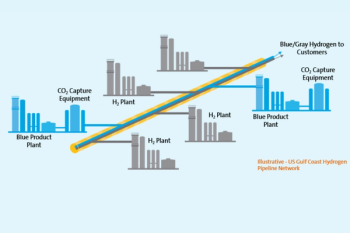
How to evaluate sites for selecting gas turbine filtration
Each gas turbine installation site has a unique make-up of contaminants. When selecting the inlet filtration system, this make-up should be determined. This includes determining what contaminants and how much are present at the site. Once this information is known, the types of filters needed and filtration efficiency required can be established.
This article contains excerpts from the paper, "Guidelines for gas turbine inlet air filtration system" by Melissa Wilcox, Richard Baldwin, Augusto Garcia-Hernandez and Klaus Brun of SouthWest Research Institute.
"The first step in this process is to define which type of environment that gas turbine will be installed in. From this, a list of possible contaminants can be assembled. Next, the site and surrounding areas should be evaluated for local contaminants. This can be confirmed through a visual survey of the area for any localized emission sources. Sources that should be noted vary from dirt roads, local agricultural sites, nearby industrial plants, or local vegetation.
Many typical localized sources are discussed above in Section 3.3. In the United States (US), the Environmental Protection Agency (EPAUS) samples airborne particles periodically at some 4000 locations. The air analysis results can be useful in determining what contaminants are present at the installation site.
Results of the surveys are published on the EPAUS’s website at the Technology Transfer Network – Clearinghouse for Inventories & Emission Factors website. This data can be accessed by any member of the public, and the data has the yearly emission levels in counties throughout the United States. The emissions are broken into various categories including SOx, CO2, various other gases and chemicals, and particulate matter emissions.
The particulate matter is divided into five categories: PM10-PRI, PM10-FIL, PM25-PRI, PM25-FIL, and PM-CON. Emissions in the PM10 category are in size range of 2.5 to 10 microns. The PM25 category is for particles less than 2.5 microns in size. The EPAUS does not track emissions larger than 10 microns. The PRI represents the primary emissions. This is the sum of the filterable and condensable emissions measured.
FIL indicates that these emissions can be filtered from the air. CON is an indication that the emissions are condensable. The CON category is only associated with fuel combustible sources. While a visual survey and the EPAUS data will provide a general list of contaminants, an air survey may be required. This is especially true for sites that do not have local data available. This survey would need to take periodic samples at the gas turbine installation site. These samples can be analyzed for the type and quantity of contaminants present.
The air quality of air sampling consultants and labs can complete this type of study. Also, the filter engineer can complete the survey themselves with proper air quality measuring equipment. The EPAUS has a list of several air quality monitoring equipment which follows the 40 CFR Part 50 methods listed on the EPAUS Technology Transfer Network – Ambient Monitoring Technology Information Center webpage.
The filter engineer must remember that the local contaminants can vary with season. The site should be surveyed several times a year. This will provide a complete list of the contaminants and contaminant levels that can be experienced. Meteorological data can provide insight into the weather experienced at the site. This data can be used to determine if anti-icing protection is required or how rigorous the water removal system needs to be.
The US Department of Commerce, National Oceanic and Atmospheric Administration (NOAA) monitors and publishes meteorological data from thousands of sites across the nation. This information can be retrieved from the NOAA website. The majority of these sites monitored are at airports and military bases. It should be noted that even with this data, the localized meteorological conditions can vary from those reported at the weather stations, especially if the site is far away from the station or in a location with significant elevation changes (i.e. in the mountains).
Once all the existing contaminants and seasonal patterns are documented, the filter engineer should consider future contaminant sources. If the site where the gas turbine will be installed is undeveloped, then future contaminants could include dirt roads during construction, emissions from future exhaust ducts, and water drift from cooling towers. Also, the local surrounding area may have agricultural expansions. This would introduce more grains and particulate matter during the harvest or growing season. Some of the future contaminants can be anticipated based on published development plans for the surrounding area.
If the information described above is collected, then the contaminants that are expected to be experienced at the site can be quantified. With this information, a proper inlet filtration system can be designed."
Newsletter
Power your knowledge with the latest in turbine technology, engineering advances, and energy solutions—subscribe to Turbomachinery International today.





